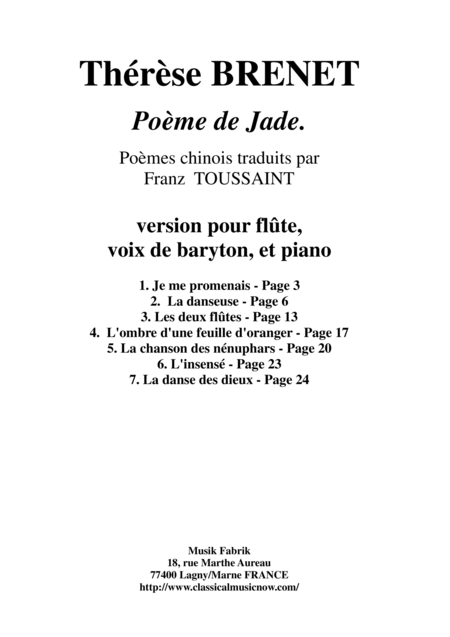Small Ensemble Flute,Medium Voice,Piano - Level 4 - Digital Download SKU: A0.532835 Composed by Therese Brenet. 20th Century,Concert,Contemporary,Standards. Score and parts. 39 pages. Musik Fabrik Music Publishing #45421. Published by Musik Fabrik Music Publishing (A0.532835). Thérèse Brenet was attracted to the Chinese poems in La Flûte de Jade by Franz Toussaint. She chose seven of these poems in a contrasting style and assembled them into a single work, striving to create an unusual orchestration which reflects this delicate, fantastic and sensual qualities of these poems. Her orchestration uses a small group of strings which are re-enforced by a harpsichord, a vibraphone, a harp and percussion, often superimposed, which serve to underline the delicate character of the poems. IN addition, she uses all styles of vocal production, from whispered passages to spoken words or screams, and from singing normally to sprechgesang. The work finishes serenely with a long melody in flute upon which the baritone repeats the last phrases of the poem in a long perdendosi. The voice and the flute slowly die away without there being a definite ending to the work, which allow the listener to imagine that the work continues, as in a waking dream. One could imagine hearing the echo of the words whispered by the baritone and the arien and luminous sounds of the flute which has lulled us as a soloist throughout the seven poems of the cycle. The orchestration is for 4 percussion, harp, harpsichord, piano and strings (44221). The piece generally lasts approximately fourteen minutes. The composer has intentionally broken with tradition by using instrumental notation for the vovcal part. This notations gives, in her view, a greater ease of reading when the voice exchanges with the flute. This version for flute, voice and piano is identical, as much as is possible, with the orchestral version, excpet for short segments in the 5th and 7th poems. These differences only affect the flute and piano parts and do not affect the vocal part. The Baritone may therefore use this score for performances with orchestra. The Flutist should use the part included in the orchestral parts for performances with orchestra. This work was first performed at the Villa Medicis during Thérèse Brenet time spend there during her Prix de Rome voyage. It was recorded in 2014 with Kurt Ollmann Baritone, Christel Rayneau, flute and the National Polish Radio Orchestra under the direction of Paul Wehage. The orchestral materials are on rental from the publisher.
